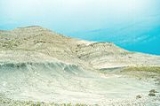
Two Medicine Formation
Encyclopedia
The Two Medicine Formation is a geologic formation
, or rock body, that was deposited between 83.5 ± 0.7 Ma to 70.6 ± 0.6 Ma (million years ago), during Campanian
(Late Cretaceous
) time, and is located in northwestern Montana
. It crops out to the east of the Rocky Mountain Overthrust Belt, and the western portion (about 600 m thick) of this formation is folded and faulted while the eastern part, which thins out into the Sweetgrass Arch, is mostly undeformed plains. Below the Two Medicine Fm. are the nearshore (beach and tidal zone) deposits of the Virgelle Sandstone, and above it is the marine Bearpaw Shale. Throughout the Campanian, the Two Medicine Fm. was deposited between the western shoreline of the Late Cretaceous Interior Seaway and the eastward advancing margin of the Cordilleran Overthrust Belt. The Two Medicine Fm. is mostly sandstone
, deposited by rivers and deltas.
A US Geological Survey crew headed by Eugene Stebinger and a US National Museum crew headed by Charles Gilmore worked together to excavate the first dinosaur of the formation. Stebinger was the first to identify the Two Medicine Formation and formally described the first fossils in a scientific paper published in 1914
. Gilmore returned to the Formation in 1928
and 1935
. During this time frame only three species were named and of these only Styracosaurus ovatus and Edmontonia rugosidens are still regarded as valid. Barnum Brown prospected the formation in 1933
, but found nothing significant. Both of their research were interrupted by World War II
. In 1977
Trexler reports finding hadrosaur remains west of Choteau, Montana
. During the next year
baby hadrosaurs were discovered. In 1979
Horner and Makela referred these hadrosaur bones to Maiasaura peeblesorum. The announcement attracted renewed scientific interest to the formation and many new kinds of dinosaurs were discovered.
deposits and bentonitic layers are common in the Two Medicine Formation.
stage. The formation has been dated using 40Ar/39Ar dating at volcanic ash layers located 10 m below the top and 105 meters above the base. The deposition of the formation may be diachronous
. The Lower Two Medicine dates to late Santonian
- early Campanian
times. The Upper Two Medicine dates to middle-late Campanian times.
). The Sweetgrass Arch in Montana divides the Two Medicine from the Judith River Formation
, Bearpaw Shale, Claggett Shale
, and Eagle Sandstone
. Across the Canadian border, the Two Medicine Formation correlates to the Belly River Group
in southwest Alberta, and the Pakowki Formation eastward.
, which formed from the beach sands exposed on northern and western shores of the receding Colorado Sea. A Cretaceous Interior Seaway transgression submerged the area briefly early on in Two Medicine history leaving anomalous paralic sediments and isolated shale
bodies about 100 m above the base of the formation. The Middle portion of the two medicine formation is about 225 m thick, deposited while the Clagette Sea was receding and the Bearpaw Sea transgressing. This portion is stratigraphically equivalent to the Judith River Formation
and Judith River Group
. The sediments are mainly bentonitic siltstones and mudstones with "occasional sandstone
lenses." These sediments are though to be the remains of a coastal plain "far removed" from the interior sea. The upper portion is about one half of the formation. Its sediments are similar to the middle portions but punctuated by extensive red beds and caliche
horizons. The uppermost 80 m were deposited after the inundation of the Judith River equivalent sediments by the Bearpaw Sea. They are thought to have been deposited in only 500,000 years. Bentonitic ash is common in the Two Medicine. To the south extrusive volcanic activity occurred in association with the Boulder Batholith
collectively called the Elkhorn Volcanics.
. This type of preservation preserves high levels of detail, even down to the microscopic level. However, it also leaves specimens vulnerable to weathering
when exposed to the surface.
 The Two Medicine Formation was deposited in a seasonal, semi-arid climate with possible rainshadows from the Cordilleran highlands. This region during the Campanian experienced a long dry season and warm temperatures. Lithologies, invertebrate faunas, and plant and pollen data support the above interpretation. The extensive red beds and caliche
The Two Medicine Formation was deposited in a seasonal, semi-arid climate with possible rainshadows from the Cordilleran highlands. This region during the Campanian experienced a long dry season and warm temperatures. Lithologies, invertebrate faunas, and plant and pollen data support the above interpretation. The extensive red beds and caliche
horizons of the upper Two Medicine are evidence of at least seasonally arid conditions. Some of the dinosaurs from the formation have been speculated to have shown signs of drought related death.
Anticline
in the Two Medicine Formation that is famous for its fossil eggs of Maiasaura, which demonstrated for the first time that at least some dinosaurs cared for their young. The eggs were arranged in dug-out earthen nests, each nest about a parent's body length from the next, and baby dinosaurs were also found with skeletons too cartilaginous for them to walk - similar to those of altricial
(helpless) baby birds. The parent(s) must then have brought food to the young, and there is plant matter in the nests that may be evidence of either this or for incubation of the eggs. Maiasaura also grew extremely fast, at rates comparable to modern birds. Skeletons of Orodromeus
and skeletons and eggs of Troodon
were also found at Egg Mountain.
The fossil record can give an appearance of faunal turnover due to multiple causes including evolution, migration, or changing preservational biases. Turnover events can have extremely minor causes like the migration of a taxon to a new area or extremely conspicuous ones like an ecosystem destroying catastrophe. Since the fossil record is incomplete assessing the nature and causes of faunal turnovers is fraught with difficulty, except in cases where the fossil record is "unusually complete." However, fossils recovered from the lower and middle part of the Two Medicine Formation tend to be scrappiy and harder to identify than those from its higher strata. In fact, identifiable skeletons from the lowest 100m of the formation are almost completely unknown and rare from the middle of the formation. Despite the low quality of the remains, however, the fossils present an extremely diverse ecosystem. Hypacrosaurus
coexisted with Maiasaura for some time, as Hypacrosaurus remains have been found lower in the formation than was earlier known. The discovery of Gryposaurus latidens in Maiasaura' s range has shown that the border between hypothesized distinct faunas in the upper and middle is less distinct than once thought. Faunal divisions between the lower and middle parts of the formation are very speculative due to the relative absence of fossils in the lowest strata. Further, there are tooth remains that seem to show the presence of certain taxa are unbroken through-out the whole of the formation. However, there seems to have been a major diversification in ornithischian taxa after the appearance of Maiasaura. Thorough examination of strata found along the Two Medicine River (which exposes the entire upper half of the Two Medicine Formation) indicates that the apparent diversification was a real event rater than a result of preservational biases. Erosional loss of chronologically equivalent Montanan strata makes comparing the Two Medicine formation to the Judith River Group
difficult.
 Earlier 1992 work by Jack Horner speculated that transitional species evolved in the uppermost part of the Two Medicine Formation during the Bearpaw Transgression for a half-million year span as the transgression inundated the Judith River Formation and later the Two Medicine area, gradually destroying the dinosaurs' preferred habitats. Horner cited certain ceratopsid and pachycephalosaurid species as possible evidence for his hypothesis. Trexler accepted that the proposal might be true for some taxa, but notes that the effected hadrosaurid
Earlier 1992 work by Jack Horner speculated that transitional species evolved in the uppermost part of the Two Medicine Formation during the Bearpaw Transgression for a half-million year span as the transgression inundated the Judith River Formation and later the Two Medicine area, gradually destroying the dinosaurs' preferred habitats. Horner cited certain ceratopsid and pachycephalosaurid species as possible evidence for his hypothesis. Trexler accepted that the proposal might be true for some taxa, but notes that the effected hadrosaurid
and tyrannosaurid taxa had actually evolved before the Bearpaw Transgression began. The most likely cause in the difference between dinosaur faunas in the Two Medicine Formation and Judith River Group is the latter being adapted to moist coastal lowlands and the former being a higher elevation somewhat arid region. Ecological separation between the different areas is the most likely explanation for faunal differences if there was no natural barrier. However there are many observations about the regions that this explanation fails to account for. Post mortem carcass transport or migration should result in shared taxa between formations but none are known. No evidence of gradual migration of Judith River taxa to the Two Medicine Formation exists even though the Two Medicine Formation should have gradually become coastal lowlands as the Judith River region was inundated by the Bearpaw Transgression. The absence of evidence for migration is conspicuous given the discovery of hundreds of dinosaur specimens in the upper Two Medicine. The Judith river formations and Two Medicine Formation shared the same northeasterly paleoflow direction in their streams, meaning they should have the same erosional source material, yet there is no evidence of this reflected in their respective facies. The Two Medicine and Judith River regions being arid and moist respectively despite exist within 100 km of each other and within the same rainshadow cast by the high mountains to the west. Trexler concludes that previously hypothesized faunal turnover boundaries may actually be due to preservational biases.
region from the lower jaw of Caenagnathus sternbergi, from the Two Medicine Formation, according to a 2001 paper by David J. Varrichio. This species had previously only been known from the Canadian province of Alberta
. Varrichio observes that during the late Campanian
, Alberta and Montana had very similar theropods despite significant differences in the types of herbivorous dinosaur faunas. Another new Montanan oviraptorosaur specimen was an Elmisaurus elegans foot reported from the Hell Creek Formation
.
, and champsosaurs. The multituberculate mammal Cimexomys
has been found on Egg Mountain. Insect
and mammal
burrows
have also been discovered, as well as dinosaur coprolites.
Geologic formation
A formation or geological formation is the fundamental unit of lithostratigraphy. A formation consists of a certain number of rock strata that have a comparable lithology, facies or other similar properties...
, or rock body, that was deposited between 83.5 ± 0.7 Ma to 70.6 ± 0.6 Ma (million years ago), during Campanian
Campanian
The Campanian is, in the ICS' geologic timescale, the fifth of six ages of the Late Cretaceous epoch . The Campanian spans the time from 83.5 ± 0.7 Ma to 70.6 ± 0.6 Ma ...
(Late Cretaceous
Late Cretaceous
The Late Cretaceous is the younger of two epochs into which the Cretaceous period is divided in the geologic timescale. Rock strata from this epoch form the Upper Cretaceous series...
) time, and is located in northwestern Montana
Montana
Montana is a state in the Western United States. The western third of Montana contains numerous mountain ranges. Smaller, "island ranges" are found in the central third of the state, for a total of 77 named ranges of the Rocky Mountains. This geographical fact is reflected in the state's name,...
. It crops out to the east of the Rocky Mountain Overthrust Belt, and the western portion (about 600 m thick) of this formation is folded and faulted while the eastern part, which thins out into the Sweetgrass Arch, is mostly undeformed plains. Below the Two Medicine Fm. are the nearshore (beach and tidal zone) deposits of the Virgelle Sandstone, and above it is the marine Bearpaw Shale. Throughout the Campanian, the Two Medicine Fm. was deposited between the western shoreline of the Late Cretaceous Interior Seaway and the eastward advancing margin of the Cordilleran Overthrust Belt. The Two Medicine Fm. is mostly sandstone
Sandstone
Sandstone is a sedimentary rock composed mainly of sand-sized minerals or rock grains.Most sandstone is composed of quartz and/or feldspar because these are the most common minerals in the Earth's crust. Like sand, sandstone may be any colour, but the most common colours are tan, brown, yellow,...
, deposited by rivers and deltas.
History of research
In 19131913 in paleontology
-Dinosaurs:* A US Geological Survey crew headed by Eugene Stebinger and a US National Museum crew headed by Charles Gilmore worked together to excavate the first dinosaur discovery of the Two Medicine Formation.-Newly named dinosaurs:...
A US Geological Survey crew headed by Eugene Stebinger and a US National Museum crew headed by Charles Gilmore worked together to excavate the first dinosaur of the formation. Stebinger was the first to identify the Two Medicine Formation and formally described the first fossils in a scientific paper published in 1914
1914 in paleontology
-Dinosaurs:* Eugene Stebinger became the first to identify the Two Medicine Formation and to formally described its first fossil finds, which were excavated the previous year.-Newly named dinosaurs:Data courtesy of George Olshevsky's dinosaur genera list and Dr...
. Gilmore returned to the Formation in 1928
1928 in paleontology
-Dinosaurs:* Charles Gilmore returned to prospect for fossils in the Two Medicine Formation. He would return yet again in 1935.-Newly named dinosaurs:Data courtesy of George Olshevsky's dinosaur genera list and Dr...
and 1935
1935 in paleontology
-Dinosaurs:* Charles Gilmore returned to prospect for fossils in the Two Medicine Formation.-New taxa:-Non-mammalian:-References:* Trexler, D., 2001, Two Medicine Formation, Montana: geology and fauna: In: Mesozoic Vertebrate Life, edited by Tanke, D. H., and Carpenter, K., Indiana University...
. During this time frame only three species were named and of these only Styracosaurus ovatus and Edmontonia rugosidens are still regarded as valid. Barnum Brown prospected the formation in 1933
1933 in paleontology
-Dinosaurs:* Barnum Brown prospected the Two Medicine Formation, but found nothing significant.* Lull published a mongraph wherein he discusses AMNH 5244, a ceratopsian braincase.-Newly named dinosaurs:...
, but found nothing significant. Both of their research were interrupted by World War II
World War II
World War II, or the Second World War , was a global conflict lasting from 1939 to 1945, involving most of the world's nations—including all of the great powers—eventually forming two opposing military alliances: the Allies and the Axis...
. In 1977
1977 in paleontology
-Dinosaurs:* Trexler found hadrosaur remains west of Choteau, Montana in Two Medicine Formation strata.-Newly named dinosaurs:Data courtesy of George Olshevsky's dinosaur genera list and Dr...
Trexler reports finding hadrosaur remains west of Choteau, Montana
Choteau, Montana
Choteau is a city in and the county seat of Teton County, Montana, United States. It lies along U.S. Routes 89 and 287 about east of the Rocky Mountains, near Flathead National Forest, the Rocky Mountain Division of Lewis and Clark National Forest, and Glacier National Park. The population was...
. During the next year
1978 in paleontology
Paleontology, palaeontology or palæontology is the study of prehistoric life forms on Earth through the examination of plant and animal fossils...
baby hadrosaurs were discovered. In 1979
1979 in paleontology
-Newly named dinosaurs:Data courtesy of George Olshevsky's dinosaur genera list and Dr. Jeremy Montague's dinosaur genus database.-New taxa:-Non-mammalian:-References:...
Horner and Makela referred these hadrosaur bones to Maiasaura peeblesorum. The announcement attracted renewed scientific interest to the formation and many new kinds of dinosaurs were discovered.
Geology
The loosely consolidated fine grain sediments composing the formation allow for fast plant growth in badland areas, limiting the number of exposed outcrops. Paleosols, fluvialFluvial
Fluvial is used in geography and Earth science to refer to the processes associated with rivers and streams and the deposits and landforms created by them...
deposits and bentonitic layers are common in the Two Medicine Formation.
Age
The Two Medicine Formation spans from 74 to 80 ma, nearly the entire length of the CampanianCampanian
The Campanian is, in the ICS' geologic timescale, the fifth of six ages of the Late Cretaceous epoch . The Campanian spans the time from 83.5 ± 0.7 Ma to 70.6 ± 0.6 Ma ...
stage. The formation has been dated using 40Ar/39Ar dating at volcanic ash layers located 10 m below the top and 105 meters above the base. The deposition of the formation may be diachronous
Diachronous
A diachronous deposit in Geology is a sedimentary rock formation in which apparently similar material varies in age from place to place....
. The Lower Two Medicine dates to late Santonian
Santonian
The Santonian is an age in the geologic timescale or a chronostratigraphic stage. It is a subdivision of the Late Cretaceous epoch or Upper Cretaceous series. It spans the time between 85.8 ± 0.7 mya and 83.5 ± 0.7 mya...
- early Campanian
Campanian
The Campanian is, in the ICS' geologic timescale, the fifth of six ages of the Late Cretaceous epoch . The Campanian spans the time from 83.5 ± 0.7 Ma to 70.6 ± 0.6 Ma ...
times. The Upper Two Medicine dates to middle-late Campanian times.
Equivalents
There are several equivalents to the Two Medicine Formation, as with many geologic formations (most of which are named after their type localityType locality (geology)
Type locality , also called type area or type locale, is the where a particular rock type, stratigraphic unit, fossil or mineral species is first identified....
). The Sweetgrass Arch in Montana divides the Two Medicine from the Judith River Formation
Judith River Formation
The Judith River Formation is a fossil-bearing geologic formation in Montana, and is part of the Judith River Group. It dates to the upper Cretaceous, between 80 and 75 million years ago, corresponding to the "Judithian" land vertebrate age...
, Bearpaw Shale, Claggett Shale
Claggett Shale
The Claggett Shale is a geological formation in Montana whose strata date back to the Late Cretaceous. Dinosaur remains are among the fossils that have been recovered from the formation.-Vertebrate paleofauna:...
, and Eagle Sandstone
Eagle Sandstone
The Eagle Sandstone is a geological formation in Montana whose strata date back to the Late Cretaceous. Dinosaur remains are among the fossils that have been recovered from the formation.-References:...
. Across the Canadian border, the Two Medicine Formation correlates to the Belly River Group
Belly River Group
The Belly River Formation is a stratigraphical unit of Late Cretaceous age in the Western Canadian Sedimentary Basin.It takes the name from the Belly River, a tributary of the Oldman River in southern Alberta, and was first described in outcrop on the banks of the Oldman River and Bow River by...
in southwest Alberta, and the Pakowki Formation eastward.
Stratigraphy
The Two Medicine overlies the Virgelle SandstoneVirgelle Sandstone
-References:* Trexler, D., 2001, Two Medicine Formation, Montana: geology and fauna: In: Mesozoic Vertebrate Life, edited by Tanke, D. H., and Carpenter, K., Indiana University Press, pp. 298–309....
, which formed from the beach sands exposed on northern and western shores of the receding Colorado Sea. A Cretaceous Interior Seaway transgression submerged the area briefly early on in Two Medicine history leaving anomalous paralic sediments and isolated shale
Shale
Shale is a fine-grained, clastic sedimentary rock composed of mud that is a mix of flakes of clay minerals and tiny fragments of other minerals, especially quartz and calcite. The ratio of clay to other minerals is variable. Shale is characterized by breaks along thin laminae or parallel layering...
bodies about 100 m above the base of the formation. The Middle portion of the two medicine formation is about 225 m thick, deposited while the Clagette Sea was receding and the Bearpaw Sea transgressing. This portion is stratigraphically equivalent to the Judith River Formation
Judith River Formation
The Judith River Formation is a fossil-bearing geologic formation in Montana, and is part of the Judith River Group. It dates to the upper Cretaceous, between 80 and 75 million years ago, corresponding to the "Judithian" land vertebrate age...
and Judith River Group
Judith River Group
The Judith River Group is a group of geologic formations in western North America dating from the late Cretaceous and noted as a site for the extensive excavation of dinosaur fossils. The formation is named after the Judith River in Montana. The group is also called the Judith River Wedge...
. The sediments are mainly bentonitic siltstones and mudstones with "occasional sandstone
Sandstone
Sandstone is a sedimentary rock composed mainly of sand-sized minerals or rock grains.Most sandstone is composed of quartz and/or feldspar because these are the most common minerals in the Earth's crust. Like sand, sandstone may be any colour, but the most common colours are tan, brown, yellow,...
lenses." These sediments are though to be the remains of a coastal plain "far removed" from the interior sea. The upper portion is about one half of the formation. Its sediments are similar to the middle portions but punctuated by extensive red beds and caliche
Caliche
Caliche may refer to:*Caliche, a hardened deposit of calcium carbonate.*Caliche slang, a collection of slang words unique to Salvadoran Spanish....
horizons. The uppermost 80 m were deposited after the inundation of the Judith River equivalent sediments by the Bearpaw Sea. They are thought to have been deposited in only 500,000 years. Bentonitic ash is common in the Two Medicine. To the south extrusive volcanic activity occurred in association with the Boulder Batholith
Boulder Batholith
The Boulder Batholith is a small batholith in southwest Montana, exposed at the surface as granite and serving as the host rock for rich mineralized deposits at Butte, Montana and other locations....
collectively called the Elkhorn Volcanics.
Taphonomy
Most of the vertebrate fossils are preserve by CaCo3 permineralizationPermineralization
Permineralization is a process of fossilization in which mineral deposits form internal casts of organisms. Carried by water, these minerals fill the spaces within organic tissue...
. This type of preservation preserves high levels of detail, even down to the microscopic level. However, it also leaves specimens vulnerable to weathering
Weathering
Weathering is the breaking down of rocks, soils and minerals as well as artificial materials through contact with the Earth's atmosphere, biota and waters...
when exposed to the surface.
Climate

Caliche
Caliche may refer to:*Caliche, a hardened deposit of calcium carbonate.*Caliche slang, a collection of slang words unique to Salvadoran Spanish....
horizons of the upper Two Medicine are evidence of at least seasonally arid conditions. Some of the dinosaurs from the formation have been speculated to have shown signs of drought related death.
Elevation
A more upland environment existed in the south of the Two Medicine formation. Paleostreams had a northeasterly flow away from these southwestern uplands. The southern part of the Two medicine formation grades into brackish water silstone/sandstone series called the Horsethief Formation. The sediments of the Horsethief represent shallower water deposits than the Bearpaw Shale adding further evidence of higher elevation areas existing in the south.Egg Mountain site
Egg Mountain was discovered in 1977 by Marion Brandvold, owner of the Trex Agate Rock Shop in Bynum, Montana, who discovered the bones of juvenile dinosaurs at this site. It is a colonial nesting site on the Willow CreekWillow Creek
Willow Creek may refer to:Places* Willow Creek No. 458, Saskatchewan* Willow Creek No. 26, Alberta* Willow Creek Provincial Park, Alberta* Willow Creek, Alaska* Willow Creek, California** Willow Creek AVA, California wine region* Willow Creek, Montana...
Anticline
Anticline
In structural geology, an anticline is a fold that is convex up and has its oldest beds at its core. The term is not to be confused with antiform, which is a purely descriptive term for any fold that is convex up. Therefore if age relationships In structural geology, an anticline is a fold that is...
in the Two Medicine Formation that is famous for its fossil eggs of Maiasaura, which demonstrated for the first time that at least some dinosaurs cared for their young. The eggs were arranged in dug-out earthen nests, each nest about a parent's body length from the next, and baby dinosaurs were also found with skeletons too cartilaginous for them to walk - similar to those of altricial
Altricial
Altricial, meaning "requiring nourishment", refers to a pattern of growth and development in organisms which are incapable of moving around on their own soon after hatching or being born...
(helpless) baby birds. The parent(s) must then have brought food to the young, and there is plant matter in the nests that may be evidence of either this or for incubation of the eggs. Maiasaura also grew extremely fast, at rates comparable to modern birds. Skeletons of Orodromeus
Orodromeus
Orodromeus is a genus of herbivorous ornithopod dinosaur from the Late Cretaceous of North America.-Discovery and naming:...
and skeletons and eggs of Troodon
Troodon
Troodon is a genus of relatively small, bird-like dinosaur from the Late Cretaceous period . Discovered in 1855, it was among the first dinosaurs found in North America...
were also found at Egg Mountain.
Biostratigraphy
In 2001, David Trexler published a review of evidence for alleged faunal turnover in the Two Medicine Formation of Montana. Most dinosaur-bearing rock formations do not contain multiple distinct stratigraphically separated faunas. Typically dinosaur faunas are static throughout a formation or change piecemeal over time. Faunal turnover usually occurs between formations.The fossil record can give an appearance of faunal turnover due to multiple causes including evolution, migration, or changing preservational biases. Turnover events can have extremely minor causes like the migration of a taxon to a new area or extremely conspicuous ones like an ecosystem destroying catastrophe. Since the fossil record is incomplete assessing the nature and causes of faunal turnovers is fraught with difficulty, except in cases where the fossil record is "unusually complete." However, fossils recovered from the lower and middle part of the Two Medicine Formation tend to be scrappiy and harder to identify than those from its higher strata. In fact, identifiable skeletons from the lowest 100m of the formation are almost completely unknown and rare from the middle of the formation. Despite the low quality of the remains, however, the fossils present an extremely diverse ecosystem. Hypacrosaurus
Hypacrosaurus
Hypacrosaurus was a genus of duckbill dinosaur similar in appearance to Corythosaurus. Like Corythosaurus, it had a tall, hollow rounded crest, although not as large and straight...
coexisted with Maiasaura for some time, as Hypacrosaurus remains have been found lower in the formation than was earlier known. The discovery of Gryposaurus latidens in Maiasaura
Judith River Group
The Judith River Group is a group of geologic formations in western North America dating from the late Cretaceous and noted as a site for the extensive excavation of dinosaur fossils. The formation is named after the Judith River in Montana. The group is also called the Judith River Wedge...
difficult.

Hadrosaurid
Hadrosaurids or duck-billed dinosaurs are members of the family Hadrosauridae, and include ornithopods such as Edmontosaurus and Parasaurolophus. They were common herbivores in the Upper Cretaceous Period of what are now Asia, Europe and North America. They are descendants of the Upper...
and tyrannosaurid taxa had actually evolved before the Bearpaw Transgression began. The most likely cause in the difference between dinosaur faunas in the Two Medicine Formation and Judith River Group is the latter being adapted to moist coastal lowlands and the former being a higher elevation somewhat arid region. Ecological separation between the different areas is the most likely explanation for faunal differences if there was no natural barrier. However there are many observations about the regions that this explanation fails to account for. Post mortem carcass transport or migration should result in shared taxa between formations but none are known. No evidence of gradual migration of Judith River taxa to the Two Medicine Formation exists even though the Two Medicine Formation should have gradually become coastal lowlands as the Judith River region was inundated by the Bearpaw Transgression. The absence of evidence for migration is conspicuous given the discovery of hundreds of dinosaur specimens in the upper Two Medicine. The Judith river formations and Two Medicine Formation shared the same northeasterly paleoflow direction in their streams, meaning they should have the same erosional source material, yet there is no evidence of this reflected in their respective facies. The Two Medicine and Judith River regions being arid and moist respectively despite exist within 100 km of each other and within the same rainshadow cast by the high mountains to the west. Trexler concludes that previously hypothesized faunal turnover boundaries may actually be due to preservational biases.
Dinosaurs
Some of the dinosaurs from the formation have been speculated to show signs of drought related death. Very few articulated dinosaurs have been found in the formation; most specimens are isolated, bone bed, poorly preserved or broken remains. Early studies assumed that the Two Medicine Formation would have the same dinosaurs as the Judith River Formation. It was only in 1978, that it was discovered that the formation had endemic dinosaurs. Even some genera regarded as wide ranging predators exhibited a species difference between the Two Medicine and other formations. No ecological barriers have been postulated apart from upland/lowland habitat preference differences between the Two Medicine and Judith River Formation. There is no unequivocal evidence for intermingling between the wildlife of the Two Medicine and geographically adjacent contemporary formations. Dinosaur remains are more common in the upper part of the Two Medicine.Ankylosaurs
| Ankylosaurs reported from the Two Medicine Formation | ||||||
|---|---|---|---|---|---|---|
| Genus | Species | Location | Stratigraphic position | Material | Notes | Images |
Edmontonia Edmontonia Edmontonia was an armoured dinosaur, a part of the nodosaur family from the Late Cretaceous Period. It is named after the Edmonton Formation , the unit of rock it was found in.-Description:... |
E. rugosidens |
|
|
 |
||
Euoplocephalus Euoplocephalus Euoplocephalus was one of the largest genera of ankylosaurian dinosaurs, at about the size of a small elephant. It is also the ankylosaurian with the best fossil record, so its extensive spiked armor, low-slung body and great club-like tail are well documented.-Description:Among the... |
E. tutus |
|
||||
|
Indeterminate |
|
|
||||
Avialans
| Avialans reported from the Two Medicine Formation | ||||||
|---|---|---|---|---|---|---|
| Genus | Species | Location | Stratigraphic position | Material | Notes | |
Avisaurus Avisaurus Avisaurus is a genus of enantiornithine bird from the Late Cretaceous of North America.Two species are known; the type species A. archibaldi and A. gloriae... |
A. gloriae |
|
"Tarsometatarsus." |
|||
Piksi Piksi Piksi barbarulna is a prehistoric bird. It lived roughly 75 million years ago in what is now Montana, USA... |
P. barbarulna |
|
Aves incertae sedis |
|||
Ceratopsians
| Ceratopsians reported from the Two Medicine Formation | ||||||
|---|---|---|---|---|---|---|
| Genus | Species | Location | Stratigraphic position | Material | Notes | Images |
Achelousaurus Achelousaurus Achelousaurus is a genus of centrosaurine ceratopsid dinosaurs from the Late Cretaceous Period of what is now North America, dated to 74 million years ago... |
A. horneri |
|
|
"[Three] partial skulls, [one] partial skeleton." |
  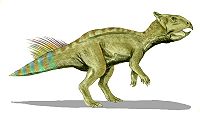 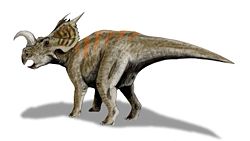 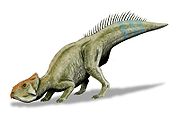 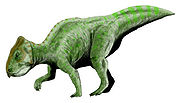 |
|
Brachyceratops Brachyceratops Brachyceratops is a dubious genus of ceratopsian dinosaur known only from partial juvenile specimens dating to the late Cretaceous Period of Montana, United States.... |
B. montanensis |
|
"[Six] partial skulls, skeletons, subadult." |
Might be juvenile of other centrosaurine species. |
||
Cerasinops Cerasinops Cerasinops was a small ceratopsian dinosaur. It lived during the Campanian of the late Cretaceous Period. Its fossils have been found in Two Medicine Formation, in Montana.... |
C. hodgskissi |
|
||||
|
Einiosaurus Einiosaurus Einiosaurus is a medium-sized centrosaurine ceratopsian from the Upper Cretaceous of northwestern Montana. The name means 'buffalo lizard', in a combination of Blackfeet Indian and Latinized Ancient Greek; the specific name Einiosaurus is a medium-sized centrosaurine (“short-frilled”)... |
E. procurvicornis |
|
|
"[Three] adult skulls, juvenile and subadult cranial and postcranial elements." |
||
Leptoceratops Leptoceratops Leptoceratops , was a primitive ceratopsian dinosaur genus from the Late Cretaceous Period of what is now Western North America, at the same time as its giant... |
Indeterminate |
|
|
|||
|
Prenoceratops Prenoceratops Prenoceratops, is a genus of ceratopsian dinosaur from the Late Cretaceous Period. Its fossils have been found in the Two Medicine Formation in the present-day U.S. state of Montana... |
P. pieganensis |
|
||||
|
Rubeosaurus Rubeosaurus Rubeosaurus is a genus of ceratopsian dinosaur which lived in what is now North America. Rubeosaurus fossils have been recovered from strata of the upper Two Medicine Formation of the Upper Cretaceous of Montana, dating to between 75 and 74 million years ago... |
R. ovatus |
|
|
"Fragmentary parietal frill." |
||
Deinonychosaurs
| Deinonychosaurs reported from the Two Medicine Formation | ||||||
|---|---|---|---|---|---|---|
| Genus | Species | Location | Stratigraphic position | Material | Notes | Images |
Bambiraptor Bambiraptor Bambiraptor is a Late Cretaceous, 75 million year old, bird-like dromaeosaurid theropod dinosaur described by scientists at the University of Kansas, Yale University, and the University of New Orleans.... |
B. feinbergorum |
|
"Almost complete skull and postcrania," type specimen |
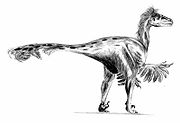 |
||
Dromaeosaurus Dromaeosaurus Dromaeosaurus was a genus of theropod dinosaur which lived during the Late Cretaceous period , sometime between 76.5 and 74.8 million years ago, in the western United States and Alberta, Canada. The name means 'running lizard'.... |
Indeterminate |
|
||||
|
Ricardoestesia Ricardoestesia Richardoestesia is a medium-sized genus of theropod dinosaur from the late Cretaceous Period of what is now North America. It is known from a single pair of lower jaw bones and a large number of isolated teeth.... |
Indeterminate |
|
Teeth |
|||
Saurornitholestes Saurornitholestes Saurornitholestes is a genus of carnivorous dromaeosaurid theropod dinosaur from the late Cretaceous of Alberta, Montana and New Mexico.... |
S. langstoni |
|
|
Partial skeleton, isolated pedal elements |
||
Troodon Troodon Troodon is a genus of relatively small, bird-like dinosaur from the Late Cretaceous period . Discovered in 1855, it was among the first dinosaurs found in North America... |
T. formosus |
|
A troodontid, also found in the Dinosaur Park Dinosaur Park Formation The Dinosaur Park Formation is the uppermost member of the Judith River Group, a major geologic unit in southern Alberta. It was laid down over a period of time between about 76.5 and 75 million years ago. The formation is made up of deposits of a high-sinuosity fluvial system, and is capped... , Judith River Judith River Formation The Judith River Formation is a fossil-bearing geologic formation in Montana, and is part of the Judith River Group. It dates to the upper Cretaceous, between 80 and 75 million years ago, corresponding to the "Judithian" land vertebrate age... , Oldman Oldman Formation The Oldman Formation is the middle member of the Judith River Group, a major geologic unit in southern Alberta. The formation is widely recognized as bearing a great number of well preserved dinosaur skeletons, as well as other fossils.-Age:... and Lance Formation Lance Formation The Lance Formation is a division of Late Cretaceous rocks in the western United States. Named after Lance Creek, Wyoming, the microvertebrate fossils and dinosaurs represent important components of the latest Mesozoic vertebrate faunas... s |
|||
Indeterminate |
|
|
||||
Ornithopods
An unidentified lambeosaurine has been collected from the same stratigraphic placement, west of Bynum, and is in preparation for the Timescale Adventures collection.| Ornithopod Ornithopod Ornithopods or members of the clade Ornithopoda are a group of ornithischian dinosaurs that started out as small, bipedal running grazers, and grew in size and numbers until they became one of the most successful groups of herbivores in the Cretaceous world, and dominated the North American... s reported from the Two Medicine Formation |
||||||
|---|---|---|---|---|---|---|
| Genus | Species | Location | Stratigraphic position | Material | Notes | Images |
Acristavus Acristavus Acristavus is a genus of hadrosaurine hadrosaurid dinosaur. Fossils have been found from the Campanian Two Medicine Formation in Montana and Wahweap Formation in Utah. The type species A. gagslarsoni was named in 2011. Unlike nearly all hadrosaurids except Edmontosaurus, Acristavus lacked... |
A. gagslarsoni |
 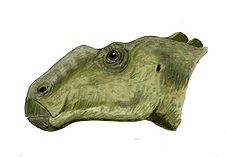  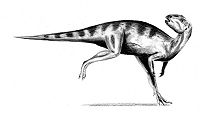  |
||||
Brachylophosaurus Brachylophosaurus Brachylophosaurus was a mid-sized member of the hadrosaurid family of dinosaurs. It is known from several skeletons and bonebed material from the Judith River Formation of Montana and the Oldman Formation of Alberta, living about 76.5 million years ago.... |
B. canadensis |
|
||||
|
Glishades Glishades Glishades is a genus of hadrosauroid dinosaur that lived in the Late Cretaceous in North America. It is based on AMNH 27414, two partial premaxillae discovered in the Upper Cretaceous rocks of the Two Medicine Formation in Montana... |
G. ericksoni |
|||||
Gryposaurus Gryposaurus Gryposaurus was a genus of duckbilled dinosaur that lived about 83 to 75.5 million years ago, in the Late Cretaceous of North America... |
G. latidens |
|
|
"Several partial skulls and postcranial skeletons." Also known from isolated teeth which may have been redeposited fossils, although this explanation is unlikely. |
The isolated G. latidens teeth are a rare component of channel lag deposits in the middle portion of the formation. |
|
Indeterminate |
|
|||||
|
Hypacrosaurus Hypacrosaurus Hypacrosaurus was a genus of duckbill dinosaur similar in appearance to Corythosaurus. Like Corythosaurus, it had a tall, hollow rounded crest, although not as large and straight... |
H. stebingeri |
|
|
|||
|
Indeterminate |
|
|
||||
|
Maiasaura Maiasaura Maiasaura is a large duck-billed dinosaur genus that lived in the area currently covered by the state of Montana in the Upper Cretaceous Period , about 74 million years ago.... |
M. peeblesorum |
|
|
"More than [two hundred] specimens including articulated skull and postcrania, embryo to adult." |
Choteau Maiasaura Maiasaura Maiasaura is a large duck-billed dinosaur genus that lived in the area currently covered by the state of Montana in the Upper Cretaceous Period , about 74 million years ago.... remains are found in higher strata than their Two Medicine River counterparts. |
|
Orodromeus Orodromeus Orodromeus is a genus of herbivorous ornithopod dinosaur from the Late Cretaceous of North America.-Discovery and naming:... |
O. makelai |
|
|
|||
|
Prosaurolophus Prosaurolophus Prosaurolophus is a genus of hadrosaurid dinosaur from the Late Cretaceous of North America. It is known from the remains of at least 25 individuals belonging to two species, including skulls and skeletons, but it remains obscure... |
P. blackfeetensis |
|
|
"Disarticulated, associated skull and postcrania pertaining to at least [four] individuals." |
||
Oviraptorosaurs
The first find of an Oviraptorosaur in Montana was an articularArticular
The articular bone is part of the lower jaw of most tetrapods, including amphibians, sauropsids and early synapsids. In these animals it is connected to two other lower jaw bones, the suprangular and the angular...
region from the lower jaw of Caenagnathus sternbergi, from the Two Medicine Formation, according to a 2001 paper by David J. Varrichio. This species had previously only been known from the Canadian province of Alberta
Alberta
Alberta is a province of Canada. It had an estimated population of 3.7 million in 2010 making it the most populous of Canada's three prairie provinces...
. Varrichio observes that during the late Campanian
Campanian
The Campanian is, in the ICS' geologic timescale, the fifth of six ages of the Late Cretaceous epoch . The Campanian spans the time from 83.5 ± 0.7 Ma to 70.6 ± 0.6 Ma ...
, Alberta and Montana had very similar theropods despite significant differences in the types of herbivorous dinosaur faunas. Another new Montanan oviraptorosaur specimen was an Elmisaurus elegans foot reported from the Hell Creek Formation
Hell Creek Formation
The Hell Creek Formation is an intensely-studied division of Upper Cretaceous to lower Paleocene rocks in North America, named for exposures studied along Hell Creek, near Jordan, Montana...
.
| Oviraptorosaurs reported from the Two Medicine Formation | ||||||
|---|---|---|---|---|---|---|
| Genus | Species | Location | Stratigraphic position | Material | Notes | Images |
Caenagnathus Caenagnathus Caenagnathus is a genus of oviraptorosaurian dinosaur from the late Cretaceous . It is known from a single lower jaw, found in the Dinosaur Park Formation of Alberta, Canada.-Taxonomic history:... |
C. sternbergi |
Known from the articular region of a lower jaw, catalogued as MOR 1107 |
Sometimes considered a synonym of Chirostenotes Chirostenotes Chirostenotes is a genus of oviraptorosaurian dinosaur from the late Cretaceous of Alberta, Canada. The type species is Chirostenotes pergracilis. Some researchers recognize a second species, C... |
 |
||
Chirostenotes Chirostenotes Chirostenotes is a genus of oviraptorosaurian dinosaur from the late Cretaceous of Alberta, Canada. The type species is Chirostenotes pergracilis. Some researchers recognize a second species, C... |
C. elegans |
|
Based on MOR 1107 |
|||
C. pergracilis |
Misclassified, based on MOR 1107 |
|||||
Tyrannosauroids
| Tyrannosauroids reported from the Two Medicine Formation | ||||||
|---|---|---|---|---|---|---|
| Genus | Species | Location | Stratigraphic position | Material | Notes | Images |
Albertosaurus Albertosaurus Albertosaurus is a genus of tyrannosaurid theropod dinosaur that lived in western North America during the Late Cretaceous Period, more than 70 million years ago. The type species, A. sarcophagus, was apparently restricted in range to the modern-day Canadian province of Alberta, after which... |
Indeterminate |
|
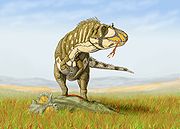 |
|||
Aublysodon Aublysodon Aublysodon is a name given to a large number of carnivorous dinosaur teeth of a certain form found in numerous late Cretaceous period geological formations... |
A. mirandus |
|
||||
|
Indeterminate |
|
|
||||
|
Daspletosaurus Daspletosaurus Daspletosaurus is a genus of tyrannosaurid theropod dinosaur that lived in western North America between 77 and 74 million years ago, during the Late Cretaceous Period. Fossils of the only named species were found in Alberta, although other possible species from Alberta and Montana await... |
D. torosus |
Misclassified, actually a new species |
||||
Unnamed |
|
|
Bonebed |
|||
Gorgosaurus Gorgosaurus Gorgosaurus is a genus of tyrannosaurid theropod dinosaur that lived in western North America during the Late Cretaceous Period, between about 76.5 and 75 million years ago. Fossil remains have been found in the Canadian province of Alberta and possibly the U.S. state of Montana.... |
G. libratus |
|
||||
|
Indeterminate |
|
|
||||
Other animals
Many other fossil animals have been found, such as freshwater bivalves, gastropods, turtles, a varanid lizardLizard
Lizards are a widespread group of squamate reptiles, with nearly 3800 species, ranging across all continents except Antarctica as well as most oceanic island chains...
, and champsosaurs. The multituberculate mammal Cimexomys
Cimexomys
Cimexomys is an extinct North American mammal that lived from the Upper Cretaceous to the Paleocene. For a while, it shared the world with dinosaurs, but outlived them. It was a member of the extinct order Multituberculata and lies within the suborder Cimolodonta...
has been found on Egg Mountain. Insect
Insect
Insects are a class of living creatures within the arthropods that have a chitinous exoskeleton, a three-part body , three pairs of jointed legs, compound eyes, and two antennae...
and mammal
Mammal
Mammals are members of a class of air-breathing vertebrate animals characterised by the possession of endothermy, hair, three middle ear bones, and mammary glands functional in mothers with young...
burrows
Burrows
Burrows is a provincial electoral division in the Canadian province of Manitoba. It was created by redistribution in 1957, and formally came into existence in the provincial election of 1958. The riding is located in the northern part of Winnipeg....
have also been discovered, as well as dinosaur coprolites.
See also
- List of fossil sites (with link directory)
- List of dinosaur-bearing rock formations

